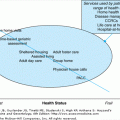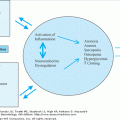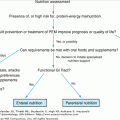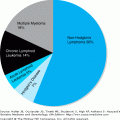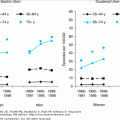The Older Surgical Patient
The progressive aging of the American population is challenging the surgical and medical communities with an expanding group of patients who will require surgical interventions much later in life. In coming years, our health care system will continue to be stressed by the need to provide surgical care that not only prolongs life but also promotes the greatest level of functional independence for older patients, without an excessive risk of complications. Among the most frequently performed surgical procedures in this age group are hip repairs, cataract extractions, coronary artery bypass grafting, cholecystectomies, and hernia repairs.
When factors influencing postoperative complications are examined, chronologic age remains an independent risk for adverse surgical outcomes. Advancing age is a marker for significant medical comorbidities that can complicate surgical procedures. The age-associated reduction in the capacity to adapt to stress, a progression in functional frailty, and the number of comorbid illnesses are better predictors than age alone for doing poorly with the rigors of surgery. In addition to increasing operative risk, these factors also prolong recovery times, promote postoperative functional declines, and increase the need for rehabilitation, nursing, and home care support after surgery. Therefore, a comprehensive review of each patient’s medical, social, cognitive, and functional status is paramount. Whenever possible, the preoperative clinical assessment should include a discussion with the primary-care physician. The primary-care physician typically has the greatest experience with the patient and is often able to provide useful insights, such as history of developing delirium during hospitalizations, which prove useful in guiding the older patient through surgery. The availability of high-quality geriatric medical care is also essential. A lack of communication between the surgical and the medical providers is a frequent reason why important clinical issues are overlooked, concerns that may have an adverse impact on the older patient’s perioperative care. Formal “comanagement” approaches have emerged, which involve both medical and surgical specialists in the perioperative period and appear to improve overall quality of care, including decreased length of stay. The critical nature of the transition between in- and outpatient and subacute care has been recognized as an important area for quality improvement at many institutions.
Because the medical and surgical managements of older patients often overlap, a comprehensive review of the medical and surgical goals and any ethical implications should be routinely completed. The primary goal of surgery is to maximize the life span of these patients in a manner that ensures dignity, self-esteem, and independent function; limits suffering and pain; and occasionally palliates adverse clinical symptoms. To accomplish these goals, an ongoing dialogue between medical and surgical providers is essential.
How Age Increases Surgical Risk
The effect of age on risk of surgery is reviewed in Chapter 37. An effort to identify reversible factors associated with perioperative morbidity in geriatric surgical patients is critical to improving surgical outcomes (Table 35-1). In patients older than 80 years, the most prevalent operative risk factors are a history of hypertension, coronary artery disease (CAD), impaired pulmonary function, and prior neurologic events. In one study of older patients, the only intraoperative event predicting a postoperative complication was the use of vasoactive agents. Twenty-five percent of these patients developed neurologic, cardiovascular, or pulmonary complications. Intraoperative events were less important than preoperative comorbidities in predicting adverse postoperative outcomes.
SYSTEM | CHANGE | SIGNIFICANCE |
|---|---|---|
General | ↓ Skeletal muscle mass | Altered volume of distribution |
↓ Thermoregulation | Potential drug toxicity | |
Greater frailty | ||
↓ Functional recovery | ||
Skin | ↓ Reepithelialization | ↓ Rate of wound healing |
↓ Dermal blood vessels | ||
Cardiac | ↑ Vascular stiffness | ↑ Blood pressure and ventricular vascular load |
↑ Ventricular stiffness | Hypertension | |
Conduction system degeneration | Ventricular hypertrophy | |
Valvular degeneration | ↑ Sensitivity to volume shifts | |
↓ Maximal heart rate | ↓ Heart rate response | |
Cardiopulmonary deconditioning | ↑ Risk of high grade arteriovenous blocks | |
↑ Prevalence of coronary artery disease | ↑ Risk of myocardial ischemia | |
Pulmonary | ↓ Elastic recoil | ↑ Potential for respiratory failure, (e.g., sedative drugs) |
↑ Chest wall stiffness | ↑ Risk of aspiration and infections | |
↑ V/Q mismatch | ||
↓ Airway protections | ||
Renal | ↓ Number of nephrons | ↓ Half-life of drugs cleared by the kidney |
↓ Decreased sodium and water excretion | ↑ Risk for fluid overload | |
Prostatic hypertrophy | ↓ Retention and infection risk | |
Immune | ↓ Immune function | ↑ Risk of infections |
Hepatic | ↓ Blood flow | ↑ Half-life for drugs cleared by the liver |
↓ Microsomal oxidation | ||
Endocrine | Insulin resistance | Hyperglycemia |
Impaired insulin secretion |
One example of how age increases operative risk is the age-associated changes in cardiac physiology. Primarily as a result of a loss of vascular compliance, the left ventricle demonstrates an increase in stiffness, impaired diastolic relaxation, and an increase in filling pressures. These changes make the ventricle less tolerant of shifts in intravascular volume. An acute increase in volume (e.g., from intravenous fluids administered during surgery) leads to a further increase in left ventricular filling pressures and could result in pulmonary congestion as a consequence of the age-related increase in diastolic stiffness. Conversely, an acute loss of intravascular volume, such as the third spacing of fluid or intraoperative blood loss, reduces preload to the stiffened ventricle and could produce a marked reduction in systolic blood pressure. CAD, a common comorbidity, increases the risk associated with these adverse age effects. Adding the intraoperative burden of myocardial ischemia to the already impaired diastolic relaxation leads to a further worsening of ventricular filling pressures and increases the risk of pulmonary edema.
Altered renal and hepatic drug metabolisms place the older patient at a greater risk of perioperative drug toxicities. A previously unrecognized disorder of cognitive function may cause an older person to decline substantially with the stress of surgery. Such a decline may present atypically, such as the development of an acute confusional episode or frank delirium. Adverse changes in cognitive function will often prolong a hospital stay and worsen clinical outcomes. Significant age- and disease-related reductions in skeletal muscle mass (sarcopenia) decrease the capacity of the older patient to make a functional recovery, possibly resulting in a discharge to a subacute or long-term care facility.
The older patient may be unable to adequately communicate concerns or clinical history to a health care provider. Therefore, to ensure the best possible surgical outcome for the older patient, it may be necessary to maximize the communication and exchange of data between the surgical team and the medical providers. Clinical programs that have fostered a closer relationship between the surgeon and the consulting internist or geriatrician have demonstrated a trend for better surgical outcomes and greater functional recoveries. Several groups within the academic community are promoting comprehensive programs to increase geriatric expertise in the surgical and medical specialties by direct education of the surgical and consulting teams in the principles of geriatric medical care. These efforts are likely to further improve operative outcomes for older patients.
In summary, because normal aging does not account for the bulk of operative risk, the clinician’s task is to identify underlying illnesses in older surgical patients and assess their impact on perioperative risk. Teamwork and communication between the various services are critical to promoting the best possible understanding of the patient’s clinical situation, helping to mitigate surgical risk.
Specific Considerations
CAD is highly prevalent in older populations and remains the primary cause of death for the elderly patient. An estimated 25% to 30% of all perioperative deaths are attributed to cardiac causes. Because older adults are more likely to have significant CAD, these patients should be carefully screened for signs and symptoms of occult or overt disease. As previously noted, the age-associated increases in vascular and left ventricular stiffness result in a greater sensitivity to volume shifts. Age-related declines in the electrical conduction system place the elderly patient at a greater a risk of drug-induced bradycardia or high-grade atrioventricular blocks. A history of prior myocardial infarction or a low ejection fraction is associated with a greater risk of ventricular tachycardia.
With advancing age, the respiratory system demonstrates several changes in function, which may include a loss of pulmonary elastic recoil, decreased diffusion capacity, and reduced cough and gag reflexes, as a consequence of either neurological injury or respiratory muscle weakness. Postoperatively, it is common for older patients to experience atelectasis or frank aspiration. An estimated 14% of older patients will have a major pulmonary perioperative complication (pneumonia, pulmonary edema, or a pulmonary embolus), particularly after an abdominal or a cardiothoracic procedure. Postoperative pneumonia in older patients is associated with a 15% to 20% mortality rate and must be treated with aggressive respiratory therapy and appropriate antimicrobials. A detailed pulmonary and occupational exposure history prior to surgery can help predict impaired respiratory function. Because neurological events that may impair airway protection are occasionally subtle, obtaining a history of swallowing difficulties or prior aspiration may prompt an early start to postoperative interventions aimed at reducing aspiration risk.
Renal function is reduced as a result of glomerular and tubular senescence. The progressive sclerosis of glomeruli that occurs with increasing age is typically hastened by comorbid conditions like hypertension, diabetes mellitus, and CAD. In the older patient, the serum creatinine often does not fully reflect the reduction in renal function. The age-associated reduction in skeletal muscle reduces creatinine production, so a reduced creatinine clearance is not always as apparent, even in the setting of diminished filtration. There is greater risk for volume and pH disturbances in the perioperative period because of baseline renal insufficiency. Medications and use of contrast dye can also contribute to renal toxicity.
Postoperative infectious complications represent a major source of morbidity and mortality for older adults. In addition, the development of a surgical site infection or other health care-acquired infection can substantially increase length of stay and associated health care costs. The extended use of indwelling devices, prolonged ventilation, and length of stay are important risk factors for postoperative infections. Infections associated with devices and prosthetic material can present unique treatment challenges. The treatment of significant infections often requires extended courses of parenteral and/or oral antimicrobial therapy, which can raise issues related to safety and tolerability of antimicrobial agents, including nephrotoxicity. Prolonged need for antimicrobials can also contribute to the development of Clostridium difficile-associated disease, which is frequently severe in older adults.
Functional impairment is an index of the severity of many chronic diseases, and its severity predicts operative risk to some degree. For example, poor performance on a bicycle ergometer is a better predictor than the Goldman criteria of surgical outcomes and postoperative pulmonary complications. The metabolic demand of surgery and the physical immobility associated with recovery may promote further declines in strength and function. Not infrequently, a previously independent older adult can become so frail postoperatively that rehabilitative care is needed. Promoting clinical services that increase physical activity and rehabilitation during the surgical recovery process may improve the level of functional independence, shorten recovery times, and prevent readmissions. Postoperatively, the “transitional” care plan must be seamless. Some patients also benefit from referral to a formal cardiac rehabilitation program.
While emergency surgeries are associated with a higher overall death rate in all age groups, this finding is most apparent in older patients who have the highest rates as a consequence of a greater number of complications. The causes for the increased risk are multifactorial. The identical surgical disease in the elderly patient may present later in its course, and diagnosis can be delayed because of an atypical presentation. Also, the elderly patient may be treated later by surgeons wishing to correct the associated comorbidities prior to surgery. In the older patient, a delay in a needed nonemergent surgery may have a greater risk if there is a chance that the delay could result in an emergent procedure. Therefore, clinicians should be aware that if the time needed to optimize the patient for surgery is extended, an anticipated elective procedure could become a higher mortality emergent procedure.
A neurologic event, such as a stroke, may increase the risk of aspiration by making it difficult to swallow, to move food through the esophagus, and to control respiratory secretions. Advancing age is also associated with a decrease in esophageal peristaltic wave amplitude, reduced tone of the lower esophageal sphincter, a greater incidence of hiatal hernias, delayed gastric emptying, and increased gastroesophageal reflux. All are factors that may increase the perioperative aspiration risk. Age-associated changes in the immune system are subtle but may contribute to a greater risk for infection from organisms that colonize the pulmonary and urinary tracts. Impaired glucose regulation and risk for stress hyperglycemia are common in this age group and may increase infection risks. Thus, careful monitoring to control blood sugars perioperatively may have important benefits. Pressure ulcers are another important postoperative complication (see Chapter 58). Age-related changes in mobility and sensation can contribute to breakdown of skin integrity. Aggressive preventative measures including frequent assessment and pressure unloading are essential aspects of postoperative management.
Taking the time to discuss the surgery with the older patients and their families promotes a clearer understanding of risk and benefits and will help to reduce the chance of false expectations with surgery. Incorporating the common geriatric care format of patient and family conferences in the surgical environment can be very helpful. In such discussions, it is often apparent that an older patient has a different outlook and acceptance of a specific level of care. Shorter-term goals, such as the quality, not quantity, of life may be most important. Additionally, the tolerance of surgery may be different than that of a younger person. The understanding that a longer time to recover may be necessary is often best communicated in this forum. It is also important to inform the patient and family that an intermediate-care program may be needed, such as a subacute care center, a rehabilitation unit, or the extended use of home care services.
Anesthesia is generally considered a safe procedure in elderly patients, with a progressive decline in complication rates being observed in recent years (see Chapter 36). Preoperative risk factors are a better predictor of 7-day mortality than is the duration of anesthesia or the experience of the anesthesiologist. The type of anesthesia (e.g., spinal vs. inhalational) fails to predict outcomes once the preoperative risk factors are controlled. The greatest period of risk for complications remains the time after surgery, with half of adverse events occurring within 3 weeks of surgery.
Stay updated, free articles. Join our Telegram channel

Full access? Get Clinical Tree


